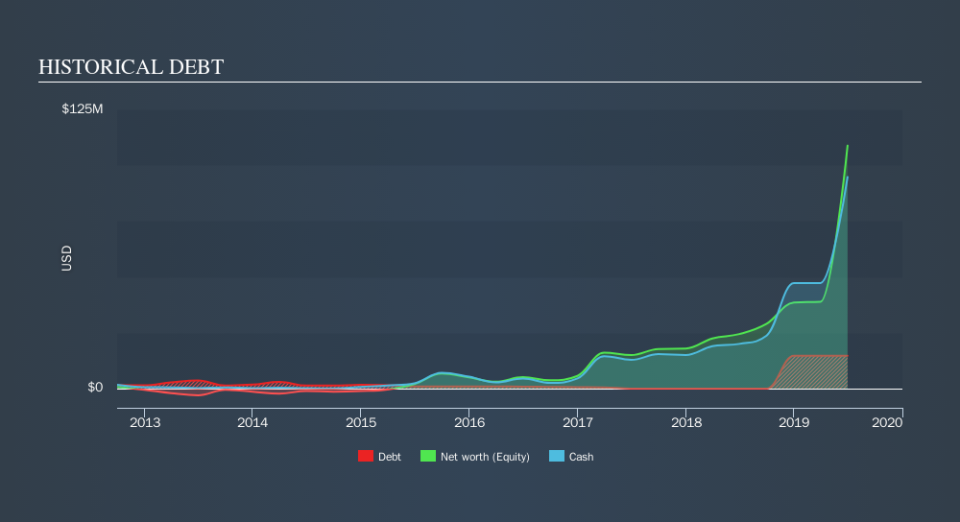Is Cryoport (NASDAQ:CYRX) Weighed On By Its Debt Load?

Some say volatility, rather than debt, is the best way to think about risk as an investor, but Warren Buffett famously said that 'Volatility is far from synonymous with risk.' It's only natural to consider a company's balance sheet when you examine how risky it is, since debt is often involved when a business collapses. We note that Cryoport, Inc. (NASDAQ:CYRX) does have debt on its balance sheet. But the real question is whether this debt is making the company risky.
When Is Debt Dangerous?
Debt and other liabilities become risky for a business when it cannot easily fulfill those obligations, either with free cash flow or by raising capital at an attractive price. Part and parcel of capitalism is the process of 'creative destruction' where failed businesses are mercilessly liquidated by their bankers. While that is not too common, we often do see indebted companies permanently diluting shareholders because lenders force them to raise capital at a distressed price. Of course, the upside of debt is that it often represents cheap capital, especially when it replaces dilution in a company with the ability to reinvest at high rates of return. The first thing to do when considering how much debt a business uses is to look at its cash and debt together.
Check out our latest analysis for Cryoport
How Much Debt Does Cryoport Carry?
The image below, which you can click on for greater detail, shows that at June 2019 Cryoport had debt of US$14.7m, up from none in one year. But on the other hand it also has US$94.7m in cash, leading to a US$80.0m net cash position.
A Look At Cryoport's Liabilities
We can see from the most recent balance sheet that Cryoport had liabilities of US$5.73m falling due within a year, and liabilities of US$18.7m due beyond that. Offsetting these obligations, it had cash of US$94.7m as well as receivables valued at US$6.10m due within 12 months. So it actually has US$76.4m more liquid assets than total liabilities.
This surplus suggests that Cryoport has a conservative balance sheet, and could probably eliminate its debt without much difficulty. Succinctly put, Cryoport boasts net cash, so it's fair to say it does not have a heavy debt load! When analysing debt levels, the balance sheet is the obvious place to start. But it is future earnings, more than anything, that will determine Cryoport's ability to maintain a healthy balance sheet going forward. So if you want to see what the professionals think, you might find this free report on analyst profit forecasts to be interesting.
In the last year Cryoport managed to grow its revenue by 74%, to US$26m. With any luck the company will be able to grow its way to profitability. However, we would also highlight that much of Cryoport's debt is set to mandatorily convert into equity in December 2019, so the debt will become less of a concern at that point.
So How Risky Is Cryoport?
By their very nature companies that are losing money are more risky than those with a long history of profitability. And in the last year Cryoport had negative earnings before interest and tax (EBIT), truth be told. And over the same period it saw negative free cash outflow of US$6.9m and booked a US$9.3m accounting loss. But the saving grace is the US$95m on the balance sheet. That kitty means the company can keep spending for growth for at least five years, at current rates. Cryoport's revenue growth shone bright over the last year, so it may well be in a position to turn a profit in due course. By investing before those profits, shareholders take on more risk in the hope of bigger rewards. When we look at a riskier company, we like to check how their profits (or losses) are trending over time. Today, we're providing readers this interactive graph showing how Cryoport's profit, revenue, and operating cashflow have changed over the last few years.
At the end of the day, it's often better to focus on companies that are free from net debt. You can access our special list of such companies (all with a track record of profit growth). It's free.
We aim to bring you long-term focused research analysis driven by fundamental data. Note that our analysis may not factor in the latest price-sensitive company announcements or qualitative material.
If you spot an error that warrants correction, please contact the editor at editorial-team@simplywallst.com. This article has been edited to include a reference to Cryoport's mandatory debt to equity conversion in December 2019. This article by Simply Wall St is general in nature. It does not constitute a recommendation to buy or sell any stock, and does not take account of your objectives, or your financial situation. Simply Wall St has no position in the stocks mentioned. Thank you for reading.

 Yahoo Finance
Yahoo Finance 
